|
Le0 posted:Guys, today my bread making didn't go as planned. If your house is cold, that is probably the cause. My house is freezing in the winter so I rise my bread in my bedroom next to the heater. If your temp doesn't hover at at least around 21 degrees celsius your rise will be delayed, much lower and it can sit for hours and not move.
|
|
|
|

|
| # ? Apr 26, 2024 20:21 |
|
Le0 posted:Guys, today my bread making didn't go as planned. Not as much liquid as usual? Colder temp leading to inadequate second rise? Are you using weights or volumes for flour?
|
|
|
|
PiratePing posted:That looks delicious, please tell me the recipe so I can garlic-bomb the house. All my recipes are in grams so if you don't have a scale sorry. 2 heads of garlic roasted and cooled 250g water 400g sourdough starter 20g yeast 450g bread flour 20g salt I added the roasted garlic mush in with the sourdough starter at the beginning of the mixing. Mix the dough and let it proof until doubled. Divide it into 2 pieces and form into a ball flatten and stretch each piece of dough into a rough oval. Place on your pan of choice lightly oiled. Slice all the way through the dough once vertically down the middle and however many you wish sorta diagonal. It's supposed to resemble a leaf. Cover and let proof for about an hour or so. Brush with olive oil and sprinkle with coarse salt. Bake at 425 for 10-15 mins.
|
|
|
|
mindphlux posted:a. how do you throw a glass of water on your pizza stone without it shattering a. It just holds up real well, it's some cheapo  stone I got from a store called Lidl. stone I got from a store called Lidl.b. I bake on a tray, the stone I just keep in the bottom to even out the ovens heat, and to make steam. c. Double perhaps, it was pretty significant, the small breads I make flat when shaping so they rise quite a lot.
|
|
|
|
Thumposaurus posted:All my recipes are in grams so if you don't have a scale sorry. Thanks! Grams are perfect. I love the Bread Baker's Apprentice but my scale doesn't do ounces and converting everything is a pain.
|
|
|
|
Do you guys have a good recipe for a basic idiot proof french bread or something? I've found plenty online, but I'm not sure which to go with.
|
|
|
|
Buttermilk biscuits make any day better:
|
|
|
|
I baked this today. I like how the crumb turned out but the top split a little edit: image too huge Hell Yeah fucked around with this message at 07:04 on Jan 30, 2014 |
|
|
|
dat crumb
|
|
|
|
Christmas Miracle posted:I baked this today. I like how the crumb turned out but the top split a little I like it. What was your formula?
|
|
|
|
it's a modified no knead bread i've been tinkering with for a while. i like the regular no knead bread but i wanted it to be a bit easier to work with, so i took out some of the water and increased the fermentation time a little. i make a smaller loaf usually: 350 g KA bread flour 270 g water 1/4 tsp yeast 10 g salt mix it all together and ferment for 15-20 hours. flour your hands and a piece of parchment and the top of the dough and get the dough out of there any way you can onto the parchment. the top (what used to be on the bottom of the bowl) should be unfloured, so start grabbing it from the bottom (floured) and pinch the unfloured part together until the skin on the floured side gets tighter, then shape it into a loaf. make some cuts in the top and immediately put the loaf with the parchment paper into a preheated dutch oven in a 425 F oven for 35 mins. remove the cover and bake another 12 minutes.
|
|
|
|
The Doctor posted:If your house is cold, that is probably the cause. My house is freezing in the winter so I rise my bread in my bedroom next to the heater. If your temp doesn't hover at at least around 21 degrees celsius your rise will be delayed, much lower and it can sit for hours and not move. That might be it, weather got colder around here recently. I will try placing the dough near a warm source. therattle posted:Not as much liquid as usual? Colder temp leading to inadequate second rise? Are you using weights or volumes for flour? I did not change the liquid ratio. Like I said I think it was the temperature. I'm using weights for flour Thanks for the inputs guys.
|
|
|
|
Christmas Miracle posted:it's a modified no knead bread i've been tinkering with for a while. i like the regular no knead bread but i wanted it to be a bit easier to work with, so i took out some of the water and increased the fermentation time a little. Wait shaped then straight into the oven no 2nd proofing after it was shaped? That's probably why it cracked on top. It's usually caused by not letting the loaf proof enough after being shaped. The outside of the bread is too tight and can't stretch as fast as the inside grows when it goes into the oven. Letting it proof a 2nd time after shaping lets the dough relax a bit. You should be able to push a finger gently into the dough and have it not spring back, that's when you know its ready to bake.
|
|
|
|
Christmas Miracle posted:it's a modified no knead bread i've been tinkering with for a while. i like the regular no knead bread but i wanted it to be a bit easier to work with, so i took out some of the water and increased the fermentation time a little. For the ferment--are you talking a fridge ferment or one on the counter? I assume fridge?
|
|
|
|
Thumposaurus posted:Wait shaped then straight into the oven no 2nd proofing after it was shaped? proofing this dough is weird. if i let it sit ten minutes on the counter the thing gets floppy and completely loses it's loaf shape. i've actually baked a bunch of loaves of this bread in the same way that didn't have a crack in the top, but the crumb wasn't as nice. Nicol Bolas posted:For the ferment--are you talking a fridge ferment or one on the counter? I assume fridge? on the counter.
|
|
|
|
So I posted this once quite some time ago, but I recently updated my weight ratio Android app and figured I'd let people know. Free, no ads, I originally made it for myself but it seemed like something that could help other people out as well. Available Here The storage permission is so that it can save recipe images.
|
|
|
|
I've been looking for exactly that for a while. Thanks!
|
|
|
|
Tried some more bread baking, this time a 70% hydration dough. Tried shaping some into the typical banh mi shape.  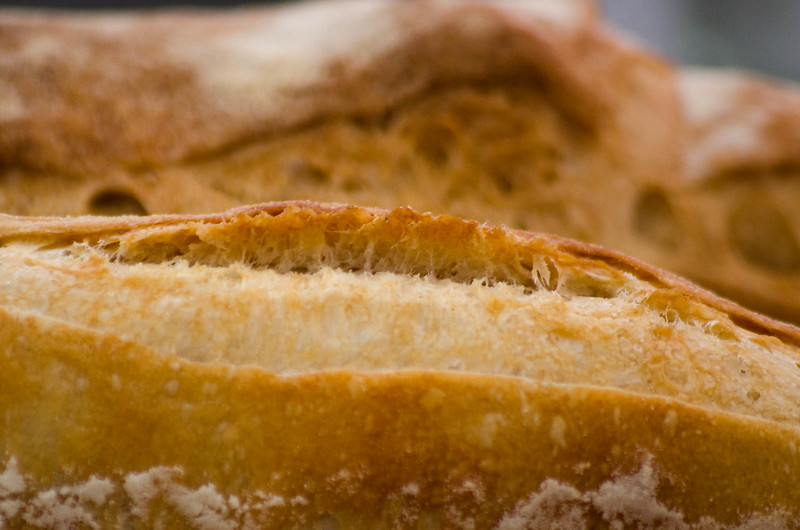 Decided to try and make a banh mi sandwich tonight and I split one roll: 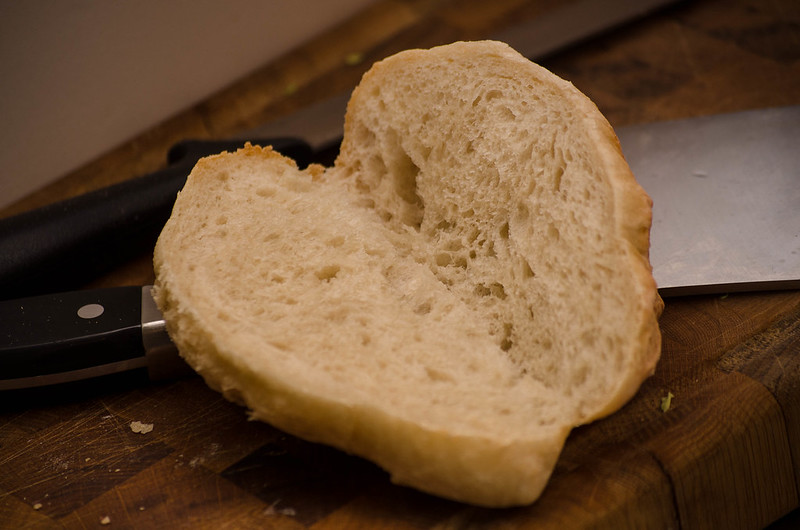 Fried up some of these chinese pork sausages along with onions and vegetables, dunno what the sausages are but they're excellent, sorta sweet tasting.  This is rather non standard I think for asian food, but I sliced up some brussel sprouts on the mandolin and sauteed them in butter with some salt & pepper. 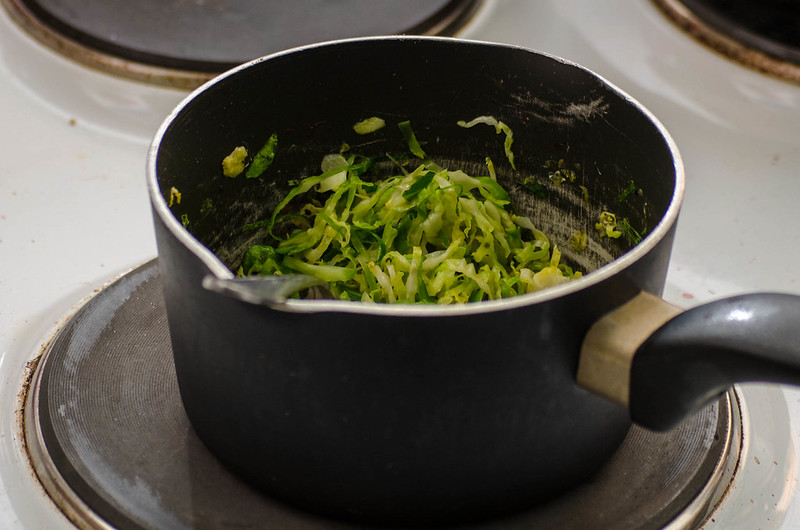 Assemble everything, with butter on one side, mayo on the other and sprinkle roasted onions on everything. 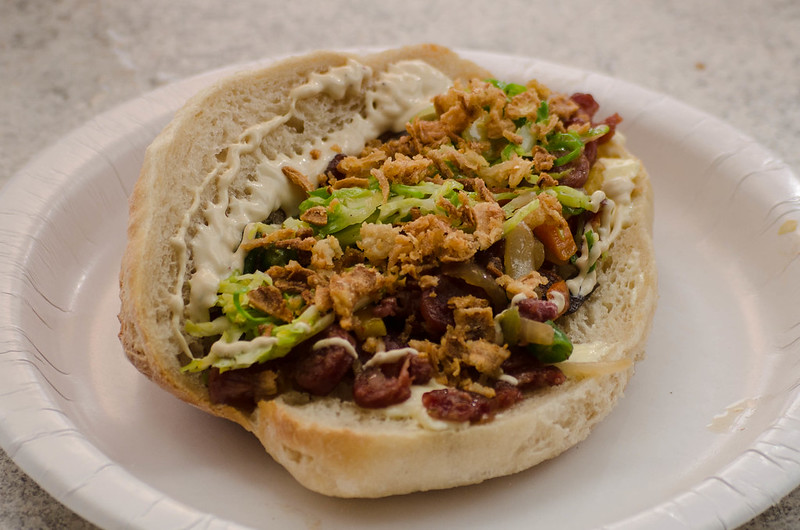 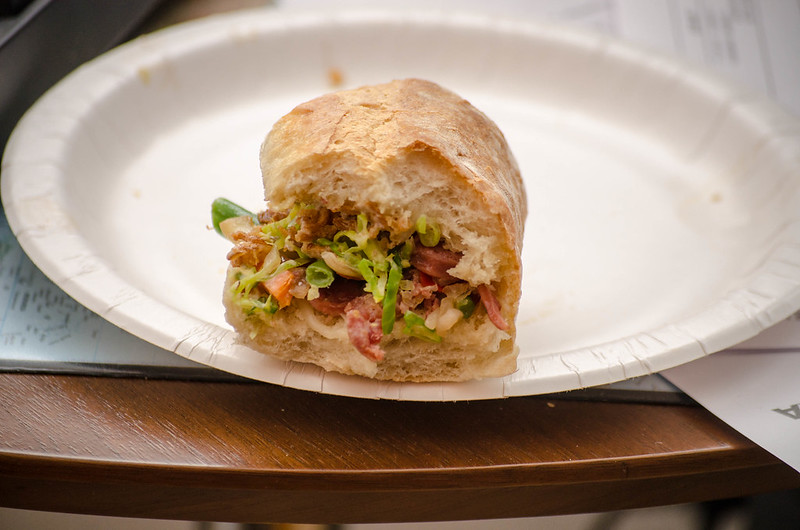
|
|
|
|
Dude, you're giving me performance anxiety when I walk into the kitchen. That looks fantastic.
|
|
|
|
|
I wanna try making a sourdough starter again, this time with higher quality flour instead of the store brand Walmart stuff. I'm using the recipe from Tartine and the book says, "mix 5 pounds of bread flour-half white and half whole wheat." Obviously I'm gonna scale down but I'm confused as to what flour to use. King Arthur seems to be a good brand and they have unbleached white whole wheat flour, whole wheat flour, and "bread flour." The white whole wheat flour is obvious but between using whole wheat flour and bread flour which one do I want?
|
|
|
|
Boris Galerkin posted:I wanna try making a sourdough starter again, this time with higher quality flour instead of the store brand Walmart stuff. I'm using the recipe from Tartine and the book says, "mix 5 pounds of bread flour-half white and half whole wheat." Obviously I'm gonna scale down but I'm confused as to what flour to use. King Arthur seems to be a good brand and they have unbleached white whole wheat flour, whole wheat flour, and "bread flour." The white whole wheat flour is obvious but between using whole wheat flour and bread flour which one do I want? I haven't done the Tartine recipe, but I would use half (white) bread flour, half whole wheat (not white whole wheat), and if you have it, some vital wheat gluten - probably 1% or so scaling.
|
|
|
|
SymmetryrtemmyS posted:I haven't done the Tartine recipe, but I would use half (white) bread flour, half whole wheat (not white whole wheat), and if you have it, some vital wheat gluten - probably 1% or so scaling. Why would you do that? Just asking cause I know nothing about bread and baking so I'm not sure what the effects of anything is. I'd eventually want to use this starter to make pizza dough too if that changes anything. King Arthur only has "bread flour" and/or "white whole wheat flour." They don't have a "white bread flour" that I can see on their website. I don't know what vital wheat gluten is.
|
|
|
|
White bread flour is simply any high protein flour with the bran and germ removed. In the US any bread flour not specifically marked 'Whole Wheat' is white bread flour. For creating a starter, any flour will work. An organic whole grain will get you started faster, but even value brand all purpose flour will do. Micro-organisms in the flour will start the fermentation, but a ripe sour starter will be dominated by yeast and bacteria from the surrounding environment. When your started is mature and you're ready to start making bread with it, you want to use a high quality flour. King Arthur is a great widely available wheat flour. There's no reason to use vital wheat gluten when you're creating a sour starter.
|
|
|
|
WhoIsYou posted:White bread flour is simply any high protein flour with the bran and germ removed. In the US any bread flour not specifically marked 'Whole Wheat' is white bread flour. Of course bread flour is usually white...if you look at his phrasing and mine, you'll see why I specified white bread flour. Is he creating a 5lb starter? That seems a bit much, and unnecessarily difficult to work with. As far as creating a starter, I use some rye flour whenever I make a new one, since it ferments very easily and essentially kickstarts the process.
|
|
|
|
I was wondering something, the water you add to make dough, what temperature should it be? Warmish? Could adding very cold water produce a smaller rise? I know this must be a stupid question but I'm trying to find out why my breads aren't rising as much as usual and I think water temperature is the only thing I've not been careful with.
|
|
|
|
I use finger warm water, I mix cold tap water with some boiling water from my electric kettle until it feels right, mix the salt & dry instant yeast into the flour. Using cold water would retard the rise and require a longer time to get to the same spot, if you added more time to that then you'd get the same rise as using hot water. I just like to control for variables on this so I always try to use finger warm water. I also like to put the dough in my oven with a pan of boiled water to keep the temp consistent and so the dough doesn't get dry skin. This apartment we're living in is also badly insulated so leaving it out tends to retard the rise.
|
|
|
|
It makes a huge difference. The colder water will make the dough take longer to proof, but in theory develops more flavor over the longer proofing period. Your water should be warm-ish but not hot. Body temp is a good goal to aim for. Anything over 120 or so can kill the yeast so you can't take it too far. The process of mixing/kneading will develop some heat as well.
|
|
|
|
Ahh well I guess I found my culprit. I don't know why but recently I didn't think about the temperature of the water I added and it was mostly very cold so I was wondering why my breads were not rising as much. Thanks 
|
|
|
|
http://www.theartisan.net/temperature_control_baking_1.htm Here's a pretty massive article that goes into detail about why it matters.
|
|
|
|
WhoIsYou posted:White bread flour is simply any high protein flour with the bran and germ removed. In the US any bread flour not specifically marked 'Whole Wheat' is white bread flour. Ok, got it. So then why would the other guy use bread flour + whole wheat flour, instead of white whole wheat + whole wheat? From what I can tell the bread flour has a 12.7% protein content while the white whole wheat has 13% (these numbers are off memory from earlier when I researched it). If the protein content is so similar than what is King Arthur bread flour (in comparison to their white whole wheat)?
|
|
|
|
Boris Galerkin posted:Ok, got it. So then why would the other guy use bread flour + whole wheat flour, instead of white whole wheat + whole wheat? From what I can tell the bread flour has a 12.7% protein content while the white whole wheat has 13% (these numbers are off memory from earlier when I researched it). If the protein content is so similar than what is King Arthur bread flour (in comparison to their white whole wheat)? Protein levels and gluten levels are related, but not synonymous. Bread flour is high in glutenin and gliadin, which form gluten in combination with water; however, whole wheat flour is high in protein, but not nearly as high in gluten-forming proteins. Hamelman goes into some more detail in his book Bread. The reason I suggest whole wheat rather than white whole wheat is simply for flavor. e: DiMuzio also has some interesting things to say in Bread Baking: An Artisan's Perspective Rye, interestingly, is rather high in gliadin, but has very little glutenin. In conjunction with a wheat flour, this gives you an excellent rise, and an even better starter. Gliadin is what triggers gluten intolerance, by the way. Gluten production and protein content are only two pieces of the puzzle, by the way: ash content is also critical for producing the correct texture and taste (as well as color) of bread. In France, the traditional baguette and artisanal loaves are made with T55 flour, which describes the ash content of that flour. In short, different flours for different purposes - and a good bread recipe should tell you what flour is intended. SymmetryrtemmyS fucked around with this message at 14:44 on Feb 3, 2014 |
|
|
|
I only use King Arthur flour when I bake my bread. My wife loves to go cheap on me and buy store brand flour, and the bread comes out not nearly as good. This past weekend I made two loves, one a basic white bread, and the other i decided to experiment and make a cinnamon butter mixture (1/4 cup melted butter, 2 teaspoon cinnamon, 1 teaspoon sugar. Mix all until combined). I flattened out the dough after the first rise with a rolling pin, spread the mixture on top of the dough, rolled into a loaf and did the second rise in the pan. Came out fantastic, my kids are half the loaf in about 20 minutes after it cooled. Will do that again. Plus it looked neat.
|
|
|
|
Cimber posted:I only use King Arthur flour when I bake my bread. My wife loves to go cheap on me and buy store brand flour, and the bread comes out not nearly as good. This past weekend I made two loves, one a basic white bread, and the other i decided to experiment and make a cinnamon butter mixture (1/4 cup melted butter, 2 teaspoon cinnamon, 1 teaspoon sugar. Mix all until combined). I flattened out the dough after the first rise with a rolling pin, spread the mixture on top of the dough, rolled into a loaf and did the second rise in the pan. Came out fantastic, my kids are half the loaf in about 20 minutes after it cooled. Will do that again. Oh, I love cinnamon (and other) roll loaves! The absolute best French toast I've had in my life was made from a cinnamon roll brioche. They're also really great to just snack on, especially if you have little ones.
|
|
|
|
SymmetryrtemmyS posted:Oh, I love cinnamon (and other) roll loaves! The absolute best French toast I've had in my life was made from a cinnamon roll brioche. They're also really great to just snack on, especially if you have little ones. yeah, I think next weekend i'll make french toast out of this stuff if any remains.
|
|
|
|
SymmetryrtemmyS posted:Protein levels and gluten levels are related, but not synonymous. Bread flour is high in glutenin and gliadin, which form gluten in combination with water; however, whole wheat flour is high in protein, but not nearly as high in gluten-forming proteins. Hamelman goes into some more detail in his book Bread. The reason I suggest whole wheat rather than white whole wheat is simply for flavor. Cool, all that information is nice to know. One point though and it may sound pendantic but you suggested bread flour instead of white whole wheat flour and that's the one I'm asking about why. I already got that I want to use whole wheat flour as the half other. It's just confusing because KA sells both a bread flour and a white whole wheat flour. (Note that this is coming from a guy who up until yesterday thought all flour was flour and equally the same.) Furthermore, say I start going down this rabbit hole and want to try more things with different flours. Would I need to cultivate an entirely new starter with said flour, or can I use my existing one? In other words, is my yeast gonna "remember" (have it in its DNA) that it's a whole wheat starter and not a rye starter?
|
|
|
|
Boris Galerkin posted:Cool, all that information is nice to know. One point though and it may sound pendantic but you suggested bread flour instead of white whole wheat flour and that's the one I'm asking about why. I already got that I want to use whole wheat flour as the half other. It's just confusing because KA sells both a bread flour and a white whole wheat flour. (Note that this is coming from a guy who up until yesterday thought all flour was flour and equally the same.) Oh, the reason you want to use bread flour for one half is for the higher available gluten. White whole wheat and bread flour have a similar protein level, but WWW doesn't have near as much available gluten as KAF bread flour...though you should be able to use KAF AP instead of the bread flour, if you want to. You can feed your starter however you want, and it'll change the taste accordingly. The reason I like to use rye to start it isn't for taste, but rather because it makes initial fermentation super easy. You can also make a starter, take half of it away, and turn that into a different starter just by feeding it with different flour.
|
|
|
|
SymmetryrtemmyS posted:Oh, the reason you want to use bread flour for one half is for the higher available gluten. White whole wheat and bread flour have a similar protein level, but WWW doesn't have near as much available gluten as KAF bread flour...though you should be able to use KAF AP instead of the bread flour, if you want to. Sorry if this was mentioned earlier in the thread, but what sort of yeast are you using? I've only used Fleischmann's Yeast, and a 'starter' is just me using 1 cup of finger warm water + sugar to ensure the yeast is still good. I also add a six oz. can of evaporated milk to the liquids before i add the flour, i find it gives a good flavor.
|
|
|
|
Cimber posted:Sorry if this was mentioned earlier in the thread, but what sort of yeast are you using? I've only used Fleischmann's Yeast, and a 'starter' is just me using 1 cup of finger warm water + sugar to ensure the yeast is still good. That's called blooming the yeast - a starter is a type of preferment usually used in sourdough, where you mix flour and water together and allow them to ferment with wild yeast for a matter of weeks to months. As far as dairy, evaporated milk works fine, as does dry milk. However, if you are going to use fresh milk (if you're out of evap for instance) make sure you scald it and let it cool first, otherwise the enzyme known as glutathione will relax your dough to a pretty extreme level by inhibiting gluten development.
|
|
|
|
Been trying to get some 80% hydration bread that's been kneaded in my stand mixer to turn out well (too lazy for the manual stretch and fold), not getting the kinda crumb I'm after though, I get this kinda result with 65-70% I think and that's much easier to handle. I mixed this using this kind of beater instead of the dough hook: Later on I think I will try using the k-beater and see if that makes a difference:  Anyway the bread, kneaded it 4 times and let it rise for 40 minutes to an hour after each time, dough still got stuck a bit to the cloth despite lots of flour, but rolling down the baguette onto the baking sheet seemed to round it out more, but it might also have caused it to collapse. Perhaps a couche is a worthwhile investment:  Scoring this dough was nearly impossible. 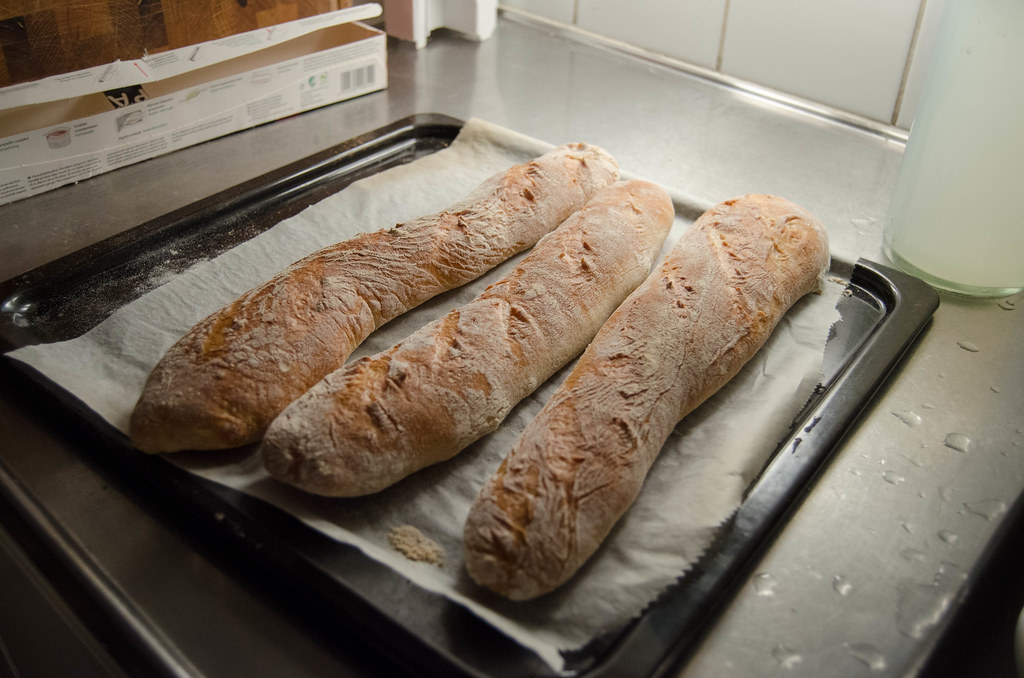 
|
|
|
|

|
| # ? Apr 26, 2024 20:21 |
|
That looks fantastic and perfect for dipping into olive oil. Want!
|
|
|


















